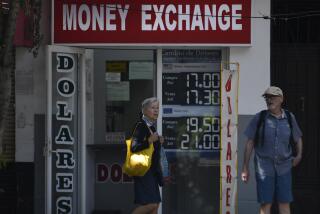Weaker Buck Has Broad Appeal
- Share via
The Bush administration still supports the idea of a “strong dollar.” Treasury Secretary John W. Snow said so again last week.
But currency traders lately have been taunting Snow to back up his words. The euro’s value rose against the dollar for eight straight sessions through Friday, when the European currency reached $1.265, its highest since February.
The buck also has been sliding in recent weeks against other major currencies. One U.S. dollar now is worth $1.23 Canadian, the lowest since 1992.
All of this is lousy news if you’re headed overseas for business or pleasure. That’s when you really see how much your purchasing power is being eroded. Other than that, foreign currency fluctuations have never taken up much space in the public consciousness.
Then again, it matters less these days what Americans think about the dollar than what foreigners, and foreign central banks, think. For the last few years, they have been supporting the dollar’s value -- or at least they’ve kept it from falling more than it has -- by being avid buyers of U.S. Treasury bonds as the nation has sunk deeper in debt.
Periodically, alarms are raised about a potential crisis if foreigners were to begin dumping their U.S. bonds, in turn driving interest rates up sharply. As usual with widely predicted crises, it hasn’t happened.
But given the amounts they’ve been buying, foreigners might not have to aggressively sell their U.S. holdings to cause a sudden shock the dollar’s value and to rattle our bond and stock markets. What if they just bought a lot less?
Concern over that possibility was partly what drove the dollar lower last week. On Monday, the Treasury issued its latest report on foreign investment in U.S. securities. The data showed that foreigners bought a net $59 billion in U.S. stocks and bonds in August.
It was the lowest net purchase sum since October 2003. (The net purchase amount is the difference between gross purchases and gross sales.)
The numbers can swing widely from month to month. But to fund the record deficit in the nation’s current account -- the broadest measure of our trade balance with the rest of the world -- the United States must import about $50 billion of net new capital monthly, said Michael Woolfolk, senior currency strategist at Bank of New York.
So the $59-billion figure for securities purchases in August didn’t leave a lot of breathing room, he noted. And that, in turn, made currency traders nervous about where the dollar might be headed.
The current-account deficit (which reached an unprecedented $530 billion in 2003, and is deepening this year) is separate from the federal budget deficit, which totaled $413 billion in the fiscal year ended Sept. 30. But the two deficits are interrelated, and more so since foreigners have loaded up on Treasury bonds since mid-2002.
The bottom line is that the nation is extraordinarily dependent on foreign money to fund its consumption. This is a fact that just about everybody knows, yet it elicits far less concern among politicians, economists and the general public than it used to. Familiarity with deficits is breeding boredom, not contempt.
Here’s where the dollar comes in: A weaker buck could reduce America’s foreign capital dependence. In theory, if the dollar fell further against the euro, the yen and other currencies, U.S. exports would become less expensive for foreign buyers. Rising exports could shrink the trade deficit.
But currency shifts are a two-way street. A devalued dollar also would mean that imports would become more expensive for Americans. That raises the risk of higher inflation. And higher inflation most likely would mean higher long-term interest rates.
For now, the bond market clearly isn’t betting that inflation will rise: The yield on the benchmark 10-year Treasury note ended at 3.97% Friday, the lowest since April 1.
Yet there were some interesting comments last week from people who are in positions to engineer a lower dollar.
Janet Yellen, president of the Federal Reserve Bank of San Francisco, in a speech referred to the dollar as being “relatively high.” The Fed could help to bring the currency down by pausing in its credit-tightening campaign, which could keep interest rates subdued and damp foreigners’ appetite for U.S. bonds.
More surprising was the strong-euro endorsement that came from some European finance ministers last week after they met in Luxembourg. Because oil is denominated worldwide in dollars, a stronger euro versus the dollar could effectively mute the effects of soaring energy costs for Europeans, the finance ministers acknowledged.
As for the Bush administration, it pays lip service to the idea of a strong dollar, but the fact is that the administration has let the dollar depreciate broadly since mid-2002.
What nobody wants, however, is a free-falling currency. The best-case scenario is that the dollar would continue to slowly work its way lower against major currencies, and that foreign investors would neither abruptly dump U.S. securities nor suddenly stage a buyer’s strike.
And as usual in discussions of the global economy, all roads go through China, the emerging economic powerhouse. China must bow to growing international pressure and allow its rigged currency to gently rise against the dollar, most economists say. That would make Chinese exports more expensive for Americans, and American exports cheaper for Chinese.
If China and much of the rest of Asia revalued their artificially depressed currencies, their appetite for American bonds also could decrease over time, helping to force the issue of a balanced federal budget.
Would this all involve pain for both America and Asia? Probably. But it would be less disruptive in a deliberate process than in a sudden crisis sparked by a speculator-fueled plunge in the dollar.
Tom Petruno can be reached at [email protected].
More to Read
Inside the business of entertainment
The Wide Shot brings you news, analysis and insights on everything from streaming wars to production — and what it all means for the future.
You may occasionally receive promotional content from the Los Angeles Times.










